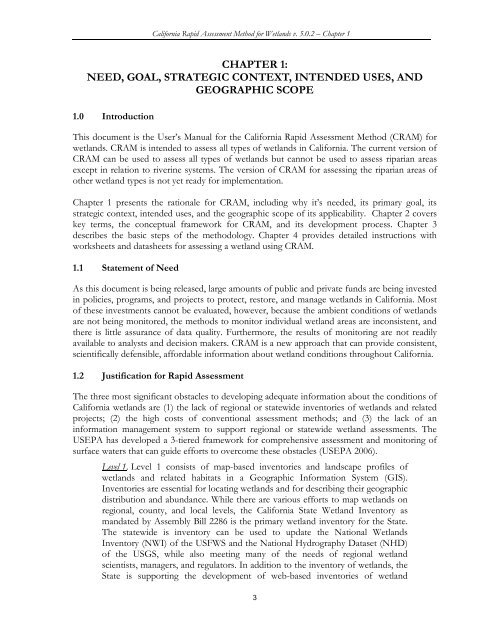(CRAM) For Wetlands User's Manual Version 5.0.2
(CRAM) For Wetlands User's Manual Version 5.0.2
(CRAM) For Wetlands User's Manual Version 5.0.2
You also want an ePaper? Increase the reach of your titles
YUMPU automatically turns print PDFs into web optimized ePapers that Google loves.
California Rapid Assessment Method for <strong>Wetlands</strong> v. <strong>5.0.2</strong> – Chapter 1<br />
CHAPTER 1:<br />
NEED, GOAL, STRATEGIC CONTEXT, INTENDED USES, AND<br />
GEOGRAPHIC SCOPE<br />
1.0 Introduction<br />
This document is the User’s <strong>Manual</strong> for the California Rapid Assessment Method (<strong>CRAM</strong>) for<br />
wetlands. <strong>CRAM</strong> is intended to assess all types of wetlands in California. The current version of<br />
<strong>CRAM</strong> can be used to assess all types of wetlands but cannot be used to assess riparian areas<br />
except in relation to riverine systems. The version of <strong>CRAM</strong> for assessing the riparian areas of<br />
other wetland types is not yet ready for implementation.<br />
Chapter 1 presents the rationale for <strong>CRAM</strong>, including why it’s needed, its primary goal, its<br />
strategic context, intended uses, and the geographic scope of its applicability. Chapter 2 covers<br />
key terms, the conceptual framework for <strong>CRAM</strong>, and its development process. Chapter 3<br />
describes the basic steps of the methodology. Chapter 4 provides detailed instructions with<br />
worksheets and datasheets for assessing a wetland using <strong>CRAM</strong>.<br />
1.1 Statement of Need<br />
As this document is being released, large amounts of public and private funds are being invested<br />
in policies, programs, and projects to protect, restore, and manage wetlands in California. Most<br />
of these investments cannot be evaluated, however, because the ambient conditions of wetlands<br />
are not being monitored, the methods to monitor individual wetland areas are inconsistent, and<br />
there is little assurance of data quality. Furthermore, the results of monitoring are not readily<br />
available to analysts and decision makers. <strong>CRAM</strong> is a new approach that can provide consistent,<br />
scientifically defensible, affordable information about wetland conditions throughout California.<br />
1.2 Justification for Rapid Assessment<br />
The three most significant obstacles to developing adequate information about the conditions of<br />
California wetlands are (1) the lack of regional or statewide inventories of wetlands and related<br />
projects; (2) the high costs of conventional assessment methods; and (3) the lack of an<br />
information management system to support regional or statewide wetland assessments. The<br />
USEPA has developed a 3-tiered framework for comprehensive assessment and monitoring of<br />
surface waters that can guide efforts to overcome these obstacles (USEPA 2006).<br />
Level 1. Level 1 consists of map-based inventories and landscape profiles of<br />
wetlands and related habitats in a Geographic Information System (GIS).<br />
Inventories are essential for locating wetlands and for describing their geographic<br />
distribution and abundance. While there are various efforts to map wetlands on<br />
regional, county, and local levels, the California State Wetland Inventory as<br />
mandated by Assembly Bill 2286 is the primary wetland inventory for the State.<br />
The statewide is inventory can be used to update the National <strong>Wetlands</strong><br />
Inventory (NWI) of the USFWS and the National Hydrography Dataset (NHD)<br />
of the USGS, while also meeting many of the needs of regional wetland<br />
scientists, managers, and regulators. In addition to the inventory of wetlands, the<br />
State is supporting the development of web-based inventories of wetland<br />
3















